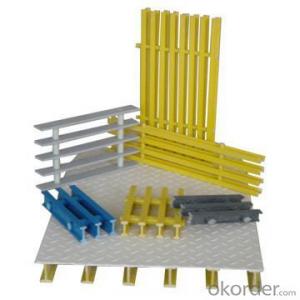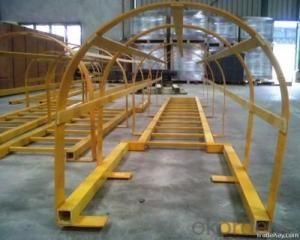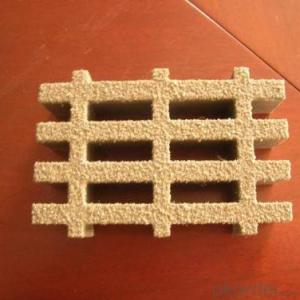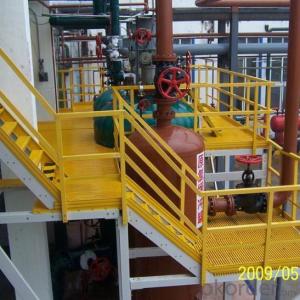FRP pultruded grating easy to installation and maintenance on sales
- Loading Port:
- Tianjin
- Payment Terms:
- TT OR LC
- Min Order Qty:
- 4000 watt
- Supply Capability:
- 100000 watt/month
OKorder Service Pledge
OKorder Financial Service
You Might Also Like
Item specifice
FRP PULTRUDED GRATING AND PULTRUSION PROCESS
PRODUCT DESCRIPTION
Pultruded grating is made by a particular assembly process, which using “I” shape as its main load-bearing and special rod to go through the bearing bar. Pultruded grating include the standard grating and the custom grating, the custom grating can be designed to meet customer’s requirement or special using condition by changing the shape, size and space of the bearing bars, the surface can be covered with lozenge panel, grit panel, or added the anti-slippery sand directly.
FRP pultruded grating has the most characteristics of molded grating, but it has its distinct advantages, it has very high fiberglass content in the loading direction, so it has very high load capability, it has more superiority when used at wide span, so that the basic support will be decreased and the project cost will be reduced accordingly.
SPECIFICATION
The standard space between two crossbars is 6 inch or 12 inch.
Thickness (mm) | Bar width (mm) | Open space (mm) | Open rate (%) | Approx weight (kg/m |
25.4 | 15.2 | 22.8 | 60 | 13.2 |
25.4 | 15.2 | 15.2 | 50 | 15.9 |
25.4 | 15.2 | 10.1 | 40 | 18.5 |
25.4 | 40 | 10.8 | 21 | 14.5 |
38.1 | 15.2 | 22.8 | 60 | 15.8 |
38.1 | 15.2 | 15.2 | 50 | 19.1 |
38.1 | 15.2 | 10.1 | 40 | 22.4 |
50.8 | 25.4 | 25.4 | 50 | 16.6 |
50.8 | 25.4 | 12.7 | 33 | 21.1 |
CHOICE FOR PULTRUDED GRATING
Resin: GP resin, ISO resin, VE resin, Phenol resin
Color choice: Yellow, gray, green, custom color
Surface choice: Groove surface, grit surface, lozenge cover surface
FEATURES
a. Anti-corrosion and anti-rust
b. Light weight and high strength
c. Anti-flammable
d. Anti- fatigue
e. Safe and anti-slippery
f. Anti-ageing
g. Easy of maintenance
h. Excellent electromagnetism property
i. Good economic benefit
FIELDS SERVED
Sewage treatment,
water supply and drainage,
chemical industry,
oil industry,
power engineering,
pulp and paper,
construction engineering,
spinning, marine engineering.
APPLICATION
Operation terrace,
stair walkway,
ground floor,
trench cover,
sidewalk,
foot bridge,
equipment safety fence,
scaffold.
COMPANT DESCRIPTION
CNBM,China National Building Materials Group is a state-owned enterprise in charge of administrative affairs in china building materials industry. Established in 1984, CNBM is a large group corporation of building materials with total assets of 25 billion RMB and a total staff of 30,000.CNBM now owns 200 subordinating firms of solely owned and joint-venture companies.
FAQ
1.Q:Are you factory or trading company ?
A:We are Factory produce FRP machines and FRP products.
2.Q:If can customized by customers requirements?
A:yes,we can produce the machine with customized size.
3.Q:How about the payment?
A:We accept any kind of payment.
4.Q:What is the guarantee?
A:Gurantee is one year.
5.Q:If you can training?
A:yes ,we can training in our factory also can send engineers to your factory training.
PICTURES
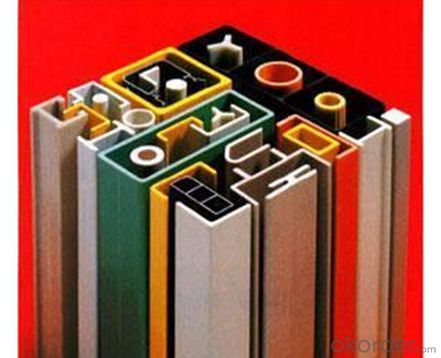
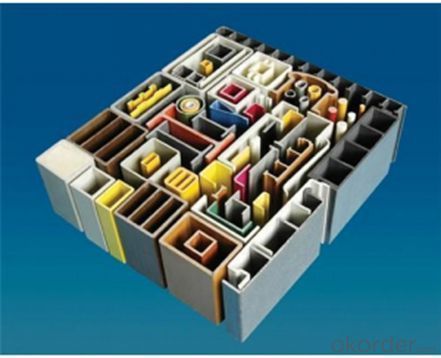
- Q:Can FRP pultrusion profiles be used in cooling towers?
- Yes, FRP (Fiber Reinforced Polymer) pultrusion profiles can be used in cooling towers. FRP pultrusion profiles offer several advantages that make them suitable for cooling tower applications. Firstly, FRP pultrusion profiles have excellent corrosion resistance, which is essential in a cooling tower environment where exposure to water and chemicals is common. Unlike traditional materials like steel, FRP pultrusion profiles do not rust or corrode, ensuring longer service life and reduced maintenance costs. Secondly, FRP pultrusion profiles have high strength-to-weight ratio, making them lightweight yet strong enough to withstand the structural requirements of cooling towers. This allows for easier installation and transportation, reducing overall project costs. Thirdly, FRP pultrusion profiles have excellent thermal insulation properties. Cooling towers involve the transfer of heat from water to the surrounding air, and the thermal insulation provided by FRP pultrusion profiles helps enhance the efficiency of the cooling process. Lastly, FRP pultrusion profiles are highly customizable and can be designed to meet specific requirements of cooling tower applications. They can be engineered to have various shapes, sizes, and dimensions to fit the specific needs of the cooling tower design. Overall, FRP pultrusion profiles are a reliable and cost-effective choice for cooling tower applications, offering corrosion resistance, high strength-to-weight ratio, thermal insulation, and customization options.
- Q:Are FRP pultrusion profiles resistant to high winds or hurricanes?
- Yes, FRP pultrusion profiles are resistant to high winds and hurricanes. The inherent strength and durability of fiberglass reinforced plastic (FRP) combined with the pultrusion manufacturing process make these profiles highly resistant to extreme weather conditions, including high winds and hurricanes. They have been extensively tested and proven to withstand strong winds and turbulent weather events.
- Q:Can FRP pultrusion profiles be used in the mining and mineral processing industry?
- The mining and mineral processing industry can indeed utilize FRP (Fiber Reinforced Polymer) pultrusion profiles. These profiles possess multiple properties that render them suitable for application in this industry. To begin with, FRP pultrusion profiles are characterized by their lightweight yet remarkably strong composition. This quality makes them ideal for situations where weight reduction holds significance, such as in mining equipment or processing plants. Despite their lightweight nature, FRP profiles can endure substantial loads and withstand corrosion. This is particularly advantageous in the mining industry, where equipment is exposed to harsh environments and corrosive substances. Furthermore, FRP pultrusion profiles are non-conductive with exceptional electrical insulation properties. This proves beneficial in mining and mineral processing operations, where electrical safety takes precedence. FRP profiles can be utilized in scenarios where electrical conductivity must be avoided, such as in electrical enclosures or cable trays. Moreover, FRP pultrusion profiles exhibit high chemical resistance, including resistance to acids and alkalis. This renders them suitable for deployment in mineral processing plants, where various corrosive chemicals are employed in mineral extraction and processing. FRP profiles can withstand exposure to these chemicals without deteriorating or sustaining significant damage, consequently increasing their lifespan and reducing maintenance costs. Additionally, FRP pultrusion profiles possess a high strength-to-weight ratio, enabling the construction of durable and lightweight structures. This proves particularly advantageous in mining operations, where structures like walkways, ladders, and platforms need to be installed in challenging terrains. The lightweight nature of FRP profiles facilitates easier transportation, handling, and installation compared to traditional materials like steel. In conclusion, FRP pultrusion profiles offer a viable option for various applications in the mining and mineral processing industry due to their lightweight composition, high strength, corrosion resistance, electrical insulation, and chemical resistance properties. These profiles present numerous advantages over traditional materials, making them a feasible choice for implementation in this industry.
- Q:Can FRP pultrusion profiles be customized or tailored to specific project requirements?
- Indeed, FRP (Fiber Reinforced Polymer) pultrusion profiles have the capability to be customized or tailored according to the specific demands of a project. The process of pultrusion, which is employed in the manufacturing, enables the creation of continuous fiber-reinforced composite profiles while providing a considerable amount of design flexibility. By adjusting the design and manufacturing parameters, the dimensions, shapes, and mechanical properties required by a project can be accommodated. The customization procedure commences with a comprehension of the project's needs and specifications. This involves identifying the desired profile dimensions, cross-sectional shape, and mechanical properties such as strength, stiffness, and durability. Based on these requirements, engineers and manufacturers can devise a personalized solution. The customization of FRP pultrusion profiles can be accomplished through various methods. Firstly, the selection of reinforcement materials, such as fiberglass, carbon fiber, or aramid fiber, can be made based on the desired mechanical characteristics. The orientation and volume fraction of the fibers can also be adjusted to optimize the strength and stiffness of the profile. Additionally, the resin matrix utilized in the pultrusion process can be customized to enhance specific properties like fire resistance, chemical resistance, or UV resistance. To meet the project's requirements, different resin systems including polyester, vinyl ester, or epoxy can be utilized. Furthermore, during the manufacturing process, the pultrusion method allows for the incorporation of additional features. This includes the addition of inserts, fastener holes, grooves, or other structural details to the profile. These modifications can be tailored to the specific project requirements, ensuring compatibility with the overall design and assembly. In conclusion, FRP pultrusion profiles offer a significant level of customization and tailoring to cater to the specific demands of a project. This versatility has made them a favored choice in various industries such as construction, infrastructure, aerospace, and automotive, where lightweight, durable, and corrosion-resistant materials are essential.
- Q:Are FRP pultrusion profiles resistant to chemicals used in agricultural applications?
- Yes, FRP pultrusion profiles are generally resistant to chemicals used in agricultural applications. FRP (Fiber Reinforced Polymer) composites have excellent chemical resistance properties, making them suitable for various agricultural environments. These profiles can withstand exposure to fertilizers, pesticides, herbicides, and other chemicals commonly used in agricultural applications without experiencing degradation or damage.
- Q:How do FRP pultrusion profiles perform in heavy-load applications?
- The exceptional performance of FRP pultrusion profiles in heavy-load applications is well-known. These profiles can withstand substantial loads without compromising structural integrity, thanks to their high strength-to-weight ratio. The pultrusion process ensures that the fibers are uniformly distributed and aligned along the length of the profile, resulting in superior strength and stiffness. In heavy-load applications, FRP pultrusion profiles demonstrate excellent load-bearing capabilities. They possess a high modulus of elasticity, enabling them to resist deformation under heavy loads and ensuring long-term durability. Moreover, these profiles have a high ultimate tensile strength, allowing them to withstand extreme forces without breaking or deforming. Additionally, FRP pultrusion profiles exhibit corrosion resistance, making them ideal for use in harsh environments. Unlike traditional materials such as steel, FRP does not rust or corrode, ensuring a longer lifespan and reduced maintenance costs. Another advantage of FRP pultrusion profiles in heavy-load applications is their electrical insulation properties. They do not conduct electricity, making them suitable for environments where electrical conductivity is a concern. Furthermore, compared to traditional materials like steel or concrete, FRP pultrusion profiles are lightweight. This characteristic simplifies transportation and installation, while also reducing overall project costs. In conclusion, FRP pultrusion profiles excel in heavy-load applications. Their high strength-to-weight ratio, excellent load-bearing capabilities, corrosion resistance, electrical insulation properties, and lightweight nature make them the preferred choice for various industries, including construction, infrastructure, marine, and transportation.
- Q:Can FRP pultrusion profiles be used in the construction of safety barriers?
- Indeed, FRP pultrusion profiles prove to be highly effective in the construction of safety barriers. When it comes to safety barrier applications, FRP pultrusion profiles surpass traditional materials like steel or concrete in numerous ways. To begin with, the strength and durability of FRP pultrusion profiles are remarkable. With their high tensile strength, these profiles can withstand substantial loads and impacts without deforming or breaking. Consequently, they are well-equipped to endure the forces that safety barriers may face, such as vehicular collisions or other accidents. Moreover, FRP pultrusion profiles possess a lightweight nature. When compared to steel or concrete, FRP is significantly lighter, which facilitates transportation, installation, and handling during construction. The reduced weight of FRP also proves advantageous in terms of ease of installation and cost-effectiveness. In addition, FRP pultrusion profiles boast excellent corrosion resistance. Unlike steel, FRP remains impervious to rust or corrosion, which can compromise the barrier's integrity and safety over time. This makes FRP particularly suitable for safety barriers exposed to outdoor environments or harsh weather conditions. Furthermore, FRP pultrusion profiles are non-conductive and non-magnetic, which presents advantages in certain safety barrier applications. For instance, in areas where electrical or magnetic interference poses a concern, such as near power lines or sensitive equipment, FRP barriers can provide an additional layer of safety by avoiding potential electrical or magnetic hazards. All in all, FRP pultrusion profiles offer a dependable and efficient solution for constructing safety barriers. Their strength, durability, lightweight nature, corrosion resistance, and non-conductive properties render them a suitable choice for a wide range of safety barrier applications.
- Q:Are FRP pultrusion profiles resistant to hydrocarbons?
- FRP pultrusion profiles are known to be resistant against hydrocarbons. By combining different reinforcing fibers, such as fiberglass or carbon fiber, with a polymer matrix, FRP materials exhibit a high level of resistance to chemical corrosion, including hydrocarbons. This resistance makes FRP pultrusion profiles an excellent choice for applications that involve exposure to hydrocarbons, such as in the oil and gas industry, chemical processing plants, and fuel storage facilities. However, it is important to bear in mind that the level of resistance may vary depending on the specific resin used in the FRP material, as well as the concentration and temperature of the hydrocarbons present. Hence, it is advisable to consult with the manufacturer or supplier of the FRP pultrusion profiles to confirm their compatibility with the particular hydrocarbon environment at hand.
- Q:Are FRP pultrusion profiles resistant to moisture or humidity?
- Yes, FRP pultrusion profiles are highly resistant to moisture and humidity. The combination of fiberglass reinforcement and resin matrix used in their construction makes them non-corrosive and impervious to water absorption. This inherent resistance ensures their durability and performance in humid or moist environments without compromising their structural integrity.
- Q:Are FRP pultrusion profiles resistant to corrosion and chemicals?
- FRP pultrusion profiles possess exceptional resistance against corrosion and chemicals. Comprising a combination of reinforcing fibers, such as fiberglass, and a polymer resin matrix, FRP exhibits unique properties that enable it to withstand a diverse array of corrosive surroundings and chemical substances. The absence of metal components in FRP pultrusion profiles grants them inherent resistance to corrosion. While metals may succumb to rust or deterioration when subjected to moisture, oxygen, or specific chemicals, FRP remains unyielding to such degradation. Consequently, FRP pultrusion profiles prove to be an ideal choice for implementation in industries like chemical processing, wastewater treatment, marine, and oil and gas. Moreover, FRP pultrusion profiles exhibit remarkable resistance to an array of chemicals, including acids, alkalis, solvents, and salts. The polymer resin matrix employed in FRP serves as a protective barrier, preventing chemical infiltration and structural profile deterioration. This steadfastness ensures that FRP pultrusion profiles can endure harsh environments without succumbing to corrosion or material degradation. In conclusion, FRP pultrusion profiles truly exemplify resistance to corrosion and chemicals. Their composition devoid of metallic elements, coupled with the protective polymer resin matrix, renders them highly durable and appropriate for a vast range of applications where corrosion and chemical resistance are of utmost importance.
1. Manufacturer Overview |
|
|---|---|
| Location | |
| Year Established | |
| Annual Output Value | |
| Main Markets | |
| Company Certifications | |
2. Manufacturer Certificates |
|
|---|---|
| a) Certification Name | |
| Range | |
| Reference | |
| Validity Period | |
3. Manufacturer Capability |
|
|---|---|
| a)Trade Capacity | |
| Nearest Port | |
| Export Percentage | |
| No.of Employees in Trade Department | |
| Language Spoken: | |
| b)Factory Information | |
| Factory Size: | |
| No. of Production Lines | |
| Contract Manufacturing | |
| Product Price Range | |
Send your message to us
FRP pultruded grating easy to installation and maintenance on sales
- Loading Port:
- Tianjin
- Payment Terms:
- TT OR LC
- Min Order Qty:
- 4000 watt
- Supply Capability:
- 100000 watt/month
OKorder Service Pledge
OKorder Financial Service
Similar products
New products
Hot products
Hot Searches
Related keywords
